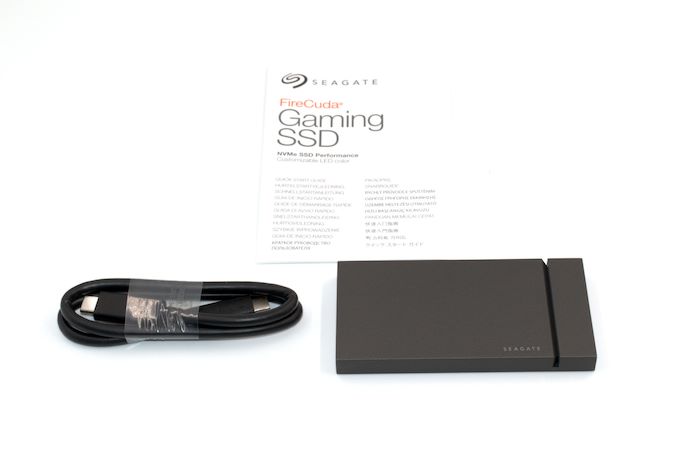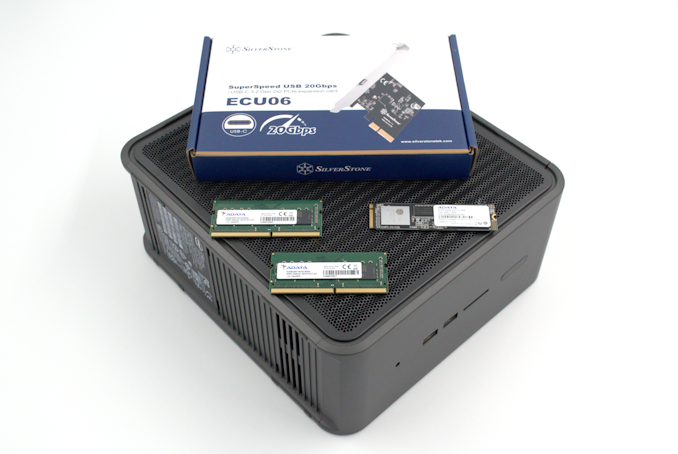Seagate FireCuda Gaming SSD Review: RGB-Infused USB 3.2 Gen 2x2 Storage
by Ganesh T S on August 27, 2021 8:00 AM EST- Posted in
- Storage
- SSDs
- Seagate
- DAS
- ASMedia
- External SSDs
- USB 3.2 Gen 2x2

The gaming market has experienced significant growth over the last decade. In addition to boosting PC sales, the peripherals market associated with the segment has also expanded. Installed sizes for games now regularly run into hundreds of gigabytes, thanks in large part to support for increased resolutions and more detailed graphics. The data also needs to be loaded into memory as fast as possible in order to improve the gaming experience.
Unsurprisingly then, gamers want the fastest possible portable SSDs to store their games. The 20 Gbps transfer rates promised by USB 3.2 Gen 2x2 has an instant appeal in this market segment. Keeping this in mind, many vendors have introduced USB 3.2 Gen 2x2 bus-powered portable SSDs targeting the gaming crowd. Last year, we looked at Western Digital's WD_BLACK P50. Seagate's FireCuda Gaming SSD was available in the market around the same time, but it didn't make it to our testbed in time for that review.
We recently got the Seagate offering into our latest testbed, and took the opportunity to refresh the numbers for the WD_BLACK P50 with our latest test suite as well. The review below looks at the performance and value proposition of the Seagate FireCuda Gaming SSD.
Introduction and Product Impressions
External bus-powered storage devices capable of 2GBps+ performance have become quite common in the market today. Rapid advancements in flash technology (including the advent of 3D NAND and NVMe) as well as faster host interfaces (such as Thunderbolt 3 and USB 3.x) have been key enablers. While USB4 (USB's most recent avatar) mandates a minimum of 10Gbps data transfer rate only, USB 3.2 Gen 2x2 (20 Gbps) has emerged as a parallel standard. It has been slow to gain traction, partly due to the lack of widespread host support in desktops and other computing platforms. While that has been changing slowly, portable SSD vendors have been hard at work creating products in this category. Professional content creators and gamers are key consumers willing to pay a premium for these high-performance devices.
On the silicon front, ASMedia happens to be the main (if not, the only) solutions supplier on the device side. Similar to the WD_BLACK P50 reviewed last year, the Seagate FireCuda Gaming SSD is also based on the ASMedia ASM2364 bridge chip, and has a premium metal construction. The FireCuda Gaming SSD's unique selling point is the available of RGB lighting that can be controlled using Seagate's Toolkit. One can dismiss RGB as a fad, but the fact is that RGB sells in the gaming market.
The FireCuda Gaming SSD is more compact (104.4 mm x 52.5 mm x 10 mm) compared to the WD_BLACK P50, while also weighing 15g lesser (100g). Only one USB 3.2 Gen 2x2 Type-C cable in supplied with the SSD, but it is longer (50cm) than the one supplied with the WD_BLACK P50. Both SSDs sport a high-performance M.2 2280 NVMe SSD inside, and have a premium metal construction.
A quick overview of the internal capabilities of the storage devices is given by CrystalDiskInfo. This also serves to verify S.M.A.R.T access from the host port. Note that we are including results from our DIY 20Gbps external SSD - the Silverstone MS12 equipped with a SK hynix Gold P31 1TB NVMe SSD.
| S.M.A.R.T Passthrough - CrystalDiskInfo | |
 |
 |
The table below presents a comparative view of the specifications of the three 1TB USB 3.2 Gen 2x2 options presented in this review.
| Comparative Direct-Attached Storage Devices Configuration | ||
| Aspect | ||
| Downstream Port | 1x PCIe 3.0 x4 (M.2 NVMe) | 1x PCIe 3.0 x4 (M.2 NVMe) |
| Upstream Port | USB 3.2 Gen 2x2 Type-C | USB 3.2 Gen 2x2 Type-C |
| Bridge Chip | ASMedia ASM2364 | ASMedia ASM2364 |
| Power | Bus Powered | Bus Powered |
| Use Case | Premium RGB-infused 2GBps-class, compact portable SSD in a gumstick form-factor targeting the gaming market | Premium 2GBps-class, compact, and sturdy portable SSD in a gumstick form-factor targeting the gaming market |
| Physical Dimensions | 104.4 mm x 52.5 mm x 10 mm | 118 mm x 62 mm x 14 mm |
| Weight | 100 grams (without cable) | 115 grams (without cable) |
| Cable | 50 cm USB 3.2 Gen 2x2 Type-C to Type-C | 30 cm USB 3.2 Gen 2x2 Type-C to Type-C 30 cm USB 3.2 Gen 2 Type-C to Type-A |
| S.M.A.R.T Passthrough | Yes | Yes |
| UASP Support | Yes | Yes |
| TRIM Passthrough | Yes | Yes |
| Hardware Encryption | Not Available | Not Available |
| Evaluated Storage | Seagate FireCuda 510 PCIe 3.0 x4 M.2 2280 NVMe SSD SanDisk / Toshiba BiCS 3 64L 3D TLC |
Western Digital SN750E PCIe 3.0 x4 M.2 2280 NVMe SSD SanDisk / Toshiba BiCS 4 96L 3D TLC |
| Price | USD 210 | USD 210 |
| Review Link | Seagate FireCuda Gaming SSD 1TB Review | WD_BLACK P50 Game Drive SSD 1TB Review #1 (2020) WD_BLACK P50 Game Drive SSD 1TB Review #2 (2021) |
Testbed Setup and Evaluation Methodology
Direct-attached storage devices such as the Seagate FireCuda Gaming SSD are evaluated using the Quartz Canyon NUC (essentially, the Xeon / ECC version of the Ghost Canyon NUC) configured with 2x 16GB DDR4-2667 ECC SODIMMs and a PCIe 3.0 x4 NVMe SSD - the IM2P33E8 1TB from ADATA.
The most attractive aspect of the Quartz Canyon NUC is the presence of two PCIe slots (electrically, x16 and x4) for add-in cards. In the absence of a discrete GPU - for which there is no need in a DAS testbed - both slots are available. In fact, we also added a spare SanDisk Extreme PRO M.2 NVMe SSD to the CPU direct-attached M.2 22110 slot in the baseboard in order to avoid DMI bottlenecks when evaluating Thunderbolt 3 devices. This still allows for two add-in cards operating at x8 (x16 electrical) and x4 (x4 electrical). Since the Quartz Canyon NUC doesn't have a native USB 3.2 Gen 2x2 port, Silverstone's SST-ECU06 add-in card was installed in the x4 slot. All non-Thunderbolt devices are tested using the Type-C port enabled by the SST-ECU06.
The specifications of the testbed are summarized in the table below:
| The 2021 AnandTech DAS Testbed Configuration | |
| System | Intel Quartz Canyon NUC9vXQNX |
| CPU | Intel Xeon E-2286M |
| Memory | ADATA Industrial AD4B3200716G22 32 GB (2x 16GB) DDR4-3200 ECC @ 22-22-22-52 |
| OS Drive | ADATA Industrial IM2P33E8 NVMe 1TB |
| Secondary Drive | SanDisk Extreme PRO M.2 NVMe 3D SSD 1TB |
| Add-on Card | SilverStone Tek SST-ECU06 USB 3.2 Gen 2x2 Type-C Host |
| OS | Windows 10 Enterprise x64 (21H1) |
| Thanks to ADATA, Intel, and SilverStone Tek for the build components | |
The testbed hardware is only one segment of the evaluation. Over the last few years, the typical direct-attached storage workloads have also evolved. High bit-rate 4K videos at 60fps have become quite common, and 8K videos are starting to make an appearance. Game install sizes have also grown steadily, thanks to high resolution textures and artwork. Backups tend to involve larger number of files, many of which are small in size. Keeping these in mind, our evaluation scheme for DAS units involves multiple workloads which are described in detail in the corresponding sections.
- Synthetic workloads using CrystalDiskMark and ATTO
- Real-world access traces using PCMark 10's storage benchmark
- Custom robocopy workloads reflective of typical DAS usage
- Sequential write stress test
In the next section, we have an overview of the performance of the Seagate FireCuda Gaming SSD in these benchmarks. Prior to providing concluding remarks, we have some observations on the drive's power consumption numbers and thermal solution also.












17 Comments
View All Comments
Flying Aardvark - Tuesday, September 7, 2021 - link
I'm waiting for the same. Though before this review came out I had already picked this Seagate drive as my choice if my hand were forced to get something. My 11900K desktop has TB4 (and thus USB4), but I'd prefer something backwards compatible with older USB as well. Samsung's X5 TB3 drive is the best thing going but no USB compatibility. For today, a USB 3.2 2x2 drive like the Seagate is as good as it gets if you want wide compatibility + decent speed.PeachNCream - Saturday, August 28, 2021 - link
Interesting product though it could stand to have a side-by-side release in beige with a more conventional single green activity LED so it matches my computer case. Its getting hard to color coordinate external components these days since everything is black and has a window in the side.Targon - Sunday, August 29, 2021 - link
There are many computer cases that don't have the clear side panel, but pre-assembled gaming computers will have them. To be honest, if you get a computer that isn't one of these generic OEM machines, even the ones with a video card, the clear side panel to allow you to see what is going on makes a certain amount of sense, especially if you have the two digit POST code display and your machine freezes up or doesn't reboot for some reason(so seeing that display actually helps). Being able to configure the LED is generally something that is getting included these days as well.back2future - Sunday, August 29, 2021 - link
Thanks, but we don't see purpose for deeper inspection on why LEDs are attracting to gamers. On users levels it adds visual attraction. Most interesting within non mainstream data paraphrasing is, that we could take these for reference for our research on AI dependent web search filtering, what earned some really inspiring replies here on Anandtech about that topic.If one wants to limit this to only one color, that would limit one approach for data quality related color output. That's just one approach on client side on these base line levels, but that would require faster interaction towards LED colors changing on devices (useful, but might require distro's drivers adaptation)? Don't know if worth effort, think, maybe better prepare for real improvements like mentioned for newer version file systems (or experimental fs' not yet released to public) and monitoring checksum's impact on cpu usage, recently? Experts did and it was impressive watching this additional data integrity monitoring dependent on LED colors output. If not visible, no information added to clients, easy. We would like to keep this on that expert quality level?
Dug - Sunday, August 29, 2021 - link
Paint it.Beige is not commonly found on any case within the last 15 years.
Cullinaire - Monday, August 30, 2021 - link
Only thing better is...discolored thru old age beigeWereweeb - Tuesday, August 31, 2021 - link
Considering that some games already exceed 200GB, and that it's likely things keep going in that direction, the DIY drive seems like a better deal to me. (Not buying anything WD for a few years after what they did with the SN550)